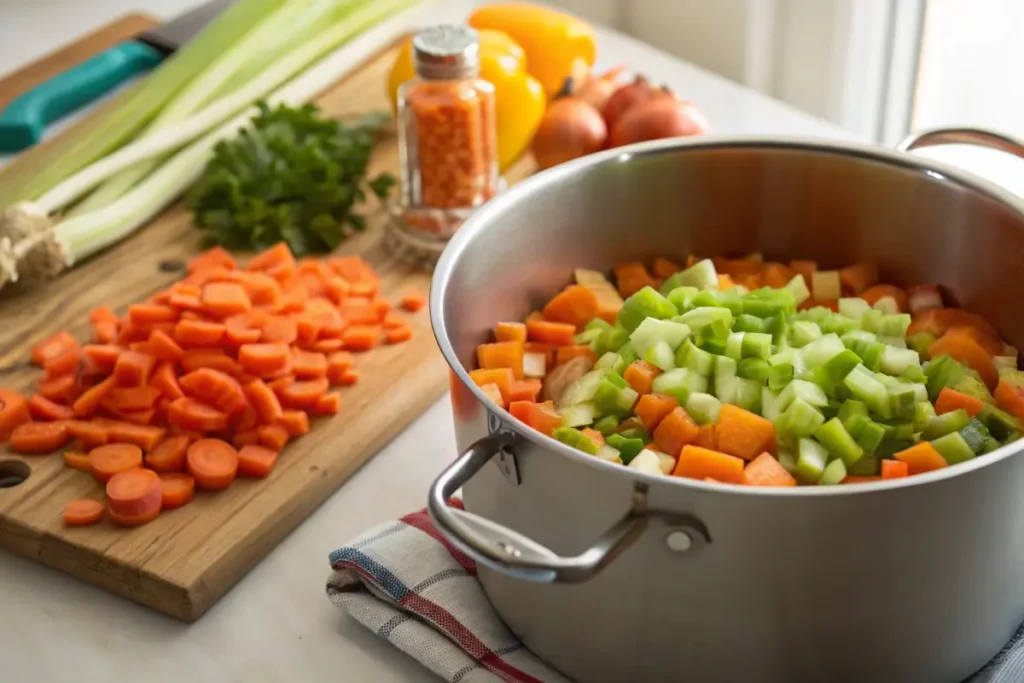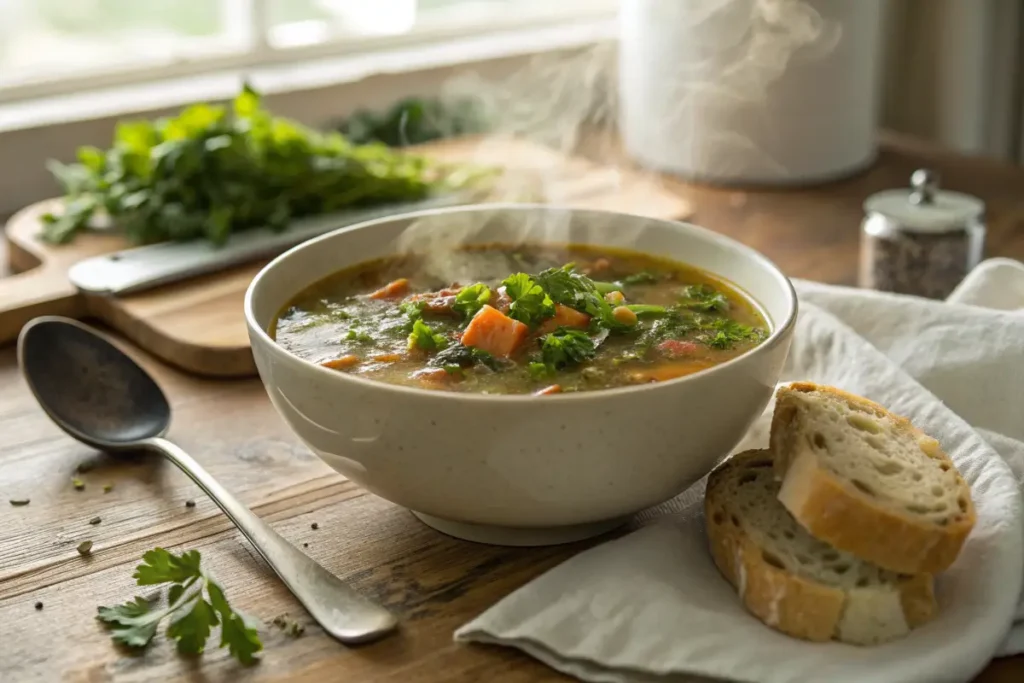In this article, we dive into the world of swamp soup, a delightful comfort food that brings warmth and flavor to any table. We’ll explore what swamp soup is, its origins, and, most importantly, how to create a scrumptious recipe you can call your own.
Whether you’re a seasoned chef or a beginner, this guide offers everything you need to whip up this hearty dish. We will also look at variations of swamp soup, tips for perfecting your recipe, and some delicious serving suggestions. So, grab your apron and let’s get started!
Introduction to Swamp Soup
What is Swamp Soup?
Swamp soup is a unique and hearty dish that has gained popularity for its comforting, rustic flavors. At its core, it’s a type of vegetable soup featuring a mix of greens, herbs, and sometimes meat, all simmered to create a rich, flavorful broth.
The name “swamp soup” comes from its vibrant green color, resembling the murky waters of a swamp. It’s a nourishing and satisfying dish, perfect for chilly evenings when you need extra warmth.
Origin and Cultural Significance
The origins of swamp soup trace back to various culinary traditions that emphasize using locally available ingredients. Many cultures have their own versions of green soups, using whatever vegetables and herbs are in season.
Whether it’s a Southern-style swamp soup or a more traditional Eastern European variant, the essence remains the same: fresh ingredients create a delicious, comforting meal. This dish not only fills your belly but also brings people together, often enjoyed during gatherings and family meals.
It’s a testament to the idea that good food doesn’t have to be complicated; it just needs love and creativity. Now that we’ve set the stage, let’s dive into the ingredients you’ll need to create your very own swamp soup recipe!
Ingredients for Swamp Soup
Essential Ingredients for a Classic Swamp Soup
To create a mouthwatering swamp soup recipe, you’ll need a variety of fresh ingredients that come together to form a delicious and hearty dish. The base typically includes leafy greens like spinach, kale, or collard greens, which give the soup its vibrant color and nutritious boost. You’ll also want to include vegetables such as carrots, celery, and onions for added flavor and texture.
Don’t forget the broth! A good vegetable or chicken broth serves as the foundation of your swamp soup, enhancing the overall taste. For those who enjoy a bit of protein, consider adding shredded chicken or sausage. These ingredients not only make the soup more filling but also add a savory depth to the flavor profile.
Optional Ingredients for Personalization
One of the best things about swamp soup is its versatility. You can easily customize your swamp soup recipe by adding herbs and spices. Fresh herbs like parsley, dill, or thyme can elevate the flavor, while spices such as garlic powder or red pepper flakes can add a kick.
If you’re feeling adventurous, try incorporating beans or lentils for extra protein and fiber. You can also toss in some pasta or rice to make it even heartier. The beauty of swamp soup lies in its adaptability; feel free to use whatever ingredients you have on hand. This way, you can create a unique version that suits your taste buds perfectly!
Step-by-Step Swamp Soup Recipe

Preparation Steps
Now that you have your ingredients ready, let’s dive into the step-by-step process of making your very own swamp soup recipe. First, start by washing and chopping all your vegetables. This includes dicing the onions, carrots, and celery into small pieces. If you’re using leafy greens, chop them into bite-sized pieces as well.
Next, gather a large pot and heat a tablespoon of olive oil over medium heat. Once the oil is hot, add the chopped onions and sauté them until they become translucent. This usually takes about 3-5 minutes. Then, toss in the carrots and celery, cooking them for another 5 minutes until they soften.
Cooking Instructions
After your vegetables are nicely sautéed, it’s time to add the broth. Pour in about 6 cups of vegetable or chicken broth, depending on your preference. Bring the mixture to a gentle boil, then reduce the heat to a simmer.
Now, add your leafy greens and any optional ingredients you’ve chosen, like beans or shredded chicken. Let the soup simmer for about 20-30 minutes, allowing all the flavors to meld together. Stir occasionally to ensure nothing sticks to the bottom of the pot.
Once the soup is ready, taste it and adjust the seasoning as needed. You might want to add a pinch of salt, pepper, or your favorite herbs. Finally, serve your swamp soup hot, garnished with fresh herbs if desired. This comforting dish is perfect for sharing with family and friends, making it a delightful addition to any meal!
Now that you know how to make this delicious swamp soup, let’s explore some variations in the next part!
Variations of Swamp Soup
Vegetarian and Vegan Swamp Soup Recipes
If you’re looking for a meat-free option, you can easily adapt your swamp soup recipe to be vegetarian or even vegan. Simply omit any meat and focus on using a rich vegetable broth. You can enhance the flavors by adding a variety of vegetables, such as zucchini, bell peppers, or mushrooms.
In addition to leafy greens, consider adding coconut milk for creaminess or nutritional yeast to give the soup a cheesy flavor without dairy. You can also mix in some beans, like black beans or chickpeas, to keep it filling and packed with protein. This way, you can enjoy a delicious and satisfying soup that fits your dietary needs!
Meat-Based Swamp Soup Recipes
For those who enjoy a heartier meal, a meat-based swamp soup is a fantastic option. You can use various meats, such as chicken, sausage, or even ham. Start by browning the meat in your pot before adding the onions and other vegetables. This step adds a wonderful depth of flavor to the broth.
Feel free to experiment with different types of meat to find your favorite combination. For example, a mix of chicken sausage and kale can create a delightful savory flavor that pairs perfectly with the greens. Just remember to adjust the cooking time based on the type of meat you use, ensuring everything is cooked through while keeping those delicious flavors intact!
Meatloaf Essentials
Find out What Not to Put in Meatloaf to avoid common mistakes.
Tips for Making the Perfect Swamp Soup
Common Mistakes to Avoid
When making your swamp soup recipe, it’s easy to make a few common mistakes along the way. One of the biggest pitfalls is rushing the cooking process. Take your time to sauté the vegetables properly; this step is crucial for developing flavor.
Another mistake is not seasoning enough. Soup can often taste bland if you don’t add enough salt or spices. So, remember to taste as you go! Lastly, avoid overcooking your greens. Adding them towards the end of the cooking time ensures they remain vibrant and full of nutrients.
Expert Tips for Flavor Enhancement
To elevate your swamp soup, consider adding a splash of lemon juice or a dash of hot sauce just before serving. These little touches can brighten the flavors and make the soup even more enjoyable.
You can also throw in some fresh herbs like basil or cilantro for an extra layer of flavor. If you’re after a creamier texture, blending a portion of the soup can create a delightful contrast with the chunky vegetables. This technique offers both a beautiful presentation and a satisfying mouthfeel.
With these tips in mind, you’re well on your way to making a swamp soup that everyone will love! Next, let’s explore some delicious serving suggestions for your creation!
Cooking Tips
Learn Should You Cook Onions Before Adding to Meatloaf? for the perfect flavor balance.
Serving Suggestions for Swamp Soup

Ideal Pairings with Swamp Soup
When it comes to enjoying your swamp soup recipe, the right pairings can elevate the meal to new heights. A simple side salad is always a great choice. A fresh green salad with a light vinaigrette can balance the richness of the soup. You might also consider serving it with crusty bread or garlic bread. The bread is perfect for dipping and soaking up all that delicious broth!
For a heartier option, you could serve your swamp soup alongside a grilled cheese sandwich. The melty, gooey cheese complements the flavors of the soup beautifully. If you’re feeling adventurous, try a panini filled with roasted vegetables or meats for an even more satisfying meal.
Presentation Ideas
Presenting your swamp soup in an appealing way can make a big difference. Consider using rustic bowls or even bread bowls to serve your soup. This not only adds charm but also keeps the soup warm longer. You can garnish each bowl with a sprinkle of fresh herbs, such as parsley or chives, to add a pop of color.
Additionally, placing a lemon wedge on the side invites guests to add a squeeze of citrus for some extra brightness. Remember, the goal is to make your swamp soup look as good as it tastes, so don’t hesitate to get a bit creative with your presentation!
Meatloaf Recipes
- Discover the Lipton Onion Soup Meatloaf Recipe that your family will love!
Nutritional Information of Swamp Soup
Caloric Content and Nutrients
When it comes to enjoying your good swamp soup recipe, it’s good to know what you’re putting into your body. Generally, a bowl of swamp soup can range from 150 to 300 calories, depending on the ingredients used. The soup is often packed with vegetables, which provide essential vitamins and minerals. For instance, leafy greens like spinach and kale are rich in vitamin A, vitamin C, and iron. Additionally, if you add proteins like chicken or beans, you’ll increase the soup’s protein content, making it even more satisfying and nutritious.
Health Benefits of Ingredients Used
The ingredients in your swamp soup offer numerous health benefits. For starters, leafy greens are known for their high antioxidant levels, which can help combat inflammation and promote overall health. Carrots provide beta-carotene, supporting eye health, while celery is great for hydration and can aid digestion. If you include legumes like beans or lentils, you’ll also benefit from added fiber, which helps with digestion and keeps you feeling full longer. Overall, swamp soup is not just delicious but also a fantastic way to nourish your body with wholesome ingredients!
FAQs
What is the history of swamp soup?
The history of swamp soup is fascinating, as it reflects the culinary traditions of various cultures. Many regions with abundant fresh vegetables and herbs have their own versions of green soups. Traditionally, swamp soup was made to use up leftover vegetables, making it both resourceful and economical.
Can I freeze swamp soup?
Absolutely! Freezing your swamp soup is a great way to enjoy it later. After preparing the soup, let it cool completely before transferring it to airtight containers or freezer bags. Make sure to leave some space at the top, as the soup may expand when frozen. When you’re ready to enjoy it again, simply thaw it in the fridge overnight and reheat it on the stove.
What are the best herbs and spices for swamp soup?
Herbs and spices can take your swamp soup recipe to the next level. Popular choices include thyme, dill, and parsley. These herbs add freshness and depth to the dish. For a little heat, consider adding red pepper flakes or cayenne pepper. If you want a more aromatic touch, garlic and onion powder are excellent options.
How long does swamp soup last in the fridge?
If stored properly, swamp soup can last in the fridge for about 3 to 4 days. Make sure to keep it in an airtight container to maintain freshness. If you notice any off smells or changes in texture, it’s best to discard it.
Conclusion: Embrace Your Swamp Soup Journey
Recap of Key Points
In this article, we’ve delved into the delightful world of swamp soup. From understanding its history and variations to discovering essential tips for preparation, you now have a comprehensive guide to creating your own swamp soup recipe.
Encouragement to Experiment and Enjoy
So, whether you’re crafting a vegetarian version or adding your favorite meats, don’t be afraid to get creative! Remember, the heart of swamp soup lies in using fresh ingredients and enjoying the cooking process. Gather your loved ones, share your delicious creation, and savor the warmth and comfort that this dish brings.
Now that you’re equipped with all this knowledge, it’s time to roll up your sleeves and start cooking. Happy soup-making, and may your kitchen always be filled with the delightful aroma of swamp soup!
Discover why your chicken piccata might taste bitter and how to fix it.
Chicken Dishes
- Try this delicious Crock Pot Chicken Piccata for an easy weeknight dinner.
Cooking Safety
- Understand Is It Okay to Put Raw Chicken in a Crock Pot? to ensure safe cooking practices.
Side Dishes
- Explore Good Sides for Chicken Piccata to complement your meal perfectly.
Cooking Issues
- Learn Why Is My Chicken Rubbery in the Crock Pot? to troubleshoot your cooking.
Recipe Comparisons
- Compare Chicken Marsala vs. Chicken Piccata to find your favorite dish.
Flavor Troubleshooting
- Discover Why Is My Chicken Piccata Bitter? and how to fix it for a better taste.






